The Routine Linen
Everyday linen
“Life is but a tissue of habits.”
— Henri-Frédéric Amiel
If we believe that, we can change our life by changing our habits. And I think that good habits are about having a good routine in our daily life. In this blog, I would like to introduce our products as things to accompany such a good daily routine.
Hemp Leaf Pattern

And this became known as the hemp leaf pattern at some point. There is a good indication of the lifestyle of the Japanese people.
Familiar Hemp
Before silk and cotton were introduced to Japan, Japanese people's cloth was mainly made of hemp. It was used not only for cloth, but also for Shinto and Buddhist rituals. Shime-nawa (sacred straw rope) at shrines are made of hemp. In August, the fire is lit with hemp shells during the Bon Festival. Hemp seeds are also used in shichimi (seven spices). In other words, hemp was a familiar agricultural product to Japanese people in the past. And this hemp grows about 3 meters in 100 days, and it grows straight. In the Edo period (1603-1867), it was counted as one of the three plants and four trees, which are most important commodity crops at that time.

This is a picture of a cluster of hemp plants. It looks somewhat like a hemp leaf pattern.
Yes, the name "hemp leaf pattern" was derived from the "appearance of hemp leaves," which were closely related to the daily life of the Japanese people.
Pattern popularized by idols
When the hemp leaf pattern was originally created, it was used exclusively for Buddhist art such as Buddhist statues. It was not until the Edo period (1603-1867) that this pattern came to be used as a costume pattern for kimonos. It is said that this pattern became popular at once when Kabuki actors, who are now considered idols, wore it. It must have looked really cool. At the same time, the pattern came to be called the hemp leaf pattern, and people at that time may have thought that the power of hemp would protect them from the causes of disease.

Representative Japanese design
By the way, how is the hemp leaf pattern made? First of all, the basic part of this pattern is composed of regular hexagons. This is a special type of regular polygon, similar to a beehive, which can be laid out on a flat surface or space without gaps, along with equilateral triangles and squares. In other words, the hemp leaf pattern can be said to be made up of these regular hexagons.

Connect the diagonals of each of these regular hexagons. This creates six equilateral triangles.

Finally, draw three isosceles triangles of the same size inside all six equilateral triangles.

Then, it turned out to be a hemp leaf pattern.

Thus, the hemp leaf pattern is one of the geometric patterns, but it came to be called so because it resembled the leaves of the hemp plant, which became a familiar pattern to the Japanese people. Today, it can be said that this design symbolizes the Japanese way of life.
Weaving hemp leaf pattern cloth
As you know, the cultivation of hemp is regulated in Japan. Spun yarn is imported from overseas under the name "hemp," but it is not the traditional Japanese spun yarn, so it is almost impossible to make hemp cloth in the traditional way.

Our company made linen textiles with the hemp leaf pattern, which has now become an important pattern for the Japanese. We made this textile not only because it represents the spirit of the Japanese people, but also because we felt it was simply beautiful as a design.

This is flax, the raw material for linen. It is very beneficial to mankind like hemp.
We would like to introduce a few of our products which are made of our hemp leaf pattern textiles.
Hemp leaf pattern scarf


Hemp leaf pattern bag&pouch



A pattern that is new in its oldness
For better progress, it is important to maintain the right balance, incorporating both the old and the new. Bags and scarves with hemp leaf patterns can be coordinated in a variety of ways at any time of the year.

Read more
“Life is but a tissue of habits.”
— Henri-Frédéric Amiel
If we believe that, we can change our life by changing our habits. And I think that good habits are about having a good routine in our daily life. In this blog, I would like to introduce our products as things to accompany such a good daily routine.
Hemp Leaf Pattern

And this became known as the hemp leaf pattern at some point. There is a good indication of the lifestyle of the Japanese people.
Familiar Hemp
Before silk and cotton were introduced to Japan, Japanese people's cloth was mainly made of hemp. It was used not only for cloth, but also for Shinto and Buddhist rituals. Shime-nawa (sacred straw rope) at shrines are made of hemp. In August, the fire is lit with hemp shells during the Bon Festival. Hemp seeds are also used in shichimi (seven spices). In other words, hemp was a familiar agricultural product to Japanese people in the past. And this hemp grows about 3 meters in 100 days, and it grows straight. In the Edo period (1603-1867), it was counted as one of the three plants and four trees, which are most important commodity crops at that time.

This is a picture of a cluster of hemp plants. It looks somewhat like a hemp leaf pattern.
Yes, the name "hemp leaf pattern" was derived from the "appearance of hemp leaves," which were closely related to the daily life of the Japanese people.
Pattern popularized by idols
When the hemp leaf pattern was originally created, it was used exclusively for Buddhist art such as Buddhist statues. It was not until the Edo period (1603-1867) that this pattern came to be used as a costume pattern for kimonos. It is said that this pattern became popular at once when Kabuki actors, who are now considered idols, wore it. It must have looked really cool. At the same time, the pattern came to be called the hemp leaf pattern, and people at that time may have thought that the power of hemp would protect them from the causes of disease.

Representative Japanese design
By the way, how is the hemp leaf pattern made? First of all, the basic part of this pattern is composed of regular hexagons. This is a special type of regular polygon, similar to a beehive, which can be laid out on a flat surface or space without gaps, along with equilateral triangles and squares. In other words, the hemp leaf pattern can be said to be made up of these regular hexagons.

Connect the diagonals of each of these regular hexagons. This creates six equilateral triangles.

Finally, draw three isosceles triangles of the same size inside all six equilateral triangles.

Then, it turned out to be a hemp leaf pattern.

Thus, the hemp leaf pattern is one of the geometric patterns, but it came to be called so because it resembled the leaves of the hemp plant, which became a familiar pattern to the Japanese people. Today, it can be said that this design symbolizes the Japanese way of life.
Weaving hemp leaf pattern cloth
As you know, the cultivation of hemp is regulated in Japan. Spun yarn is imported from overseas under the name "hemp," but it is not the traditional Japanese spun yarn, so it is almost impossible to make hemp cloth in the traditional way.

Our company made linen textiles with the hemp leaf pattern, which has now become an important pattern for the Japanese. We made this textile not only because it represents the spirit of the Japanese people, but also because we felt it was simply beautiful as a design.

This is flax, the raw material for linen. It is very beneficial to mankind like hemp.
We would like to introduce a few of our products which are made of our hemp leaf pattern textiles.
Hemp leaf pattern scarf


Hemp leaf pattern bag&pouch



A pattern that is new in its oldness
For better progress, it is important to maintain the right balance, incorporating both the old and the new. Bags and scarves with hemp leaf patterns can be coordinated in a variety of ways at any time of the year.

Read more
“Life is but a tissue of habits.”
— Henri-Frédéric Amiel
If we believe that, we can change our life by changing our habits. And I think that good habits are about having a good routine in our daily life. In this blog, I would like to introduce our products as things to accompany such a good daily routine.
Yarn-dyed Linen Daily Bag
Now, we would like to introduce our Yarn-dyed Daily Bag. Its fabric is a yarn-dyed linen fabric woven in our own factory. Of course, it is selvedge linen. The luster and coloring unique to yarn-dyed linen fabrics look just like a silk scarf. We hope that you will use this cloth bag as your companion when you go out for shopping, etc., with the same excitement as when you go out wearing your favorite scarf.


The Origami Culture
Let's take a quick look at what AZUMA BUKURO is all about. When you look at how it is made, you will be amazed at its wisdom. Please look at the diagram below.
First, prepare a rectangular piece of cloth. Fold it into three equal parts.

Next, sew A and B together at the red dotted line.

Then, insert C between A and B, which were sewn together earlier, and now sew B and C together at the green dotted line.

Finally, turn it over and you are done.

What do you think? Just two stitches are all it takes to make a bag. And if you have a rectangle of fabric, you don't even need scissors. I think that perhaps it comes from the origami culture.
The Washable Bag
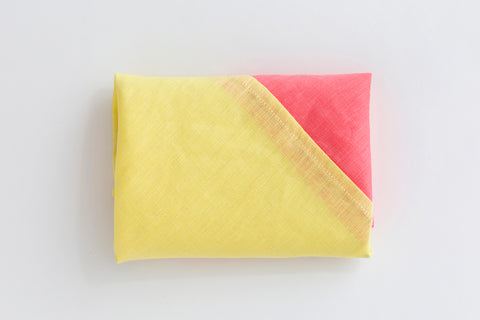
One of the advantages of linen is that it dries quickly after washing.

Sturdily Sewn
Now let's look at the details. Our main concern is its sturdy construction. It is designed to withstand considerable weight.
All seams are double stitched.
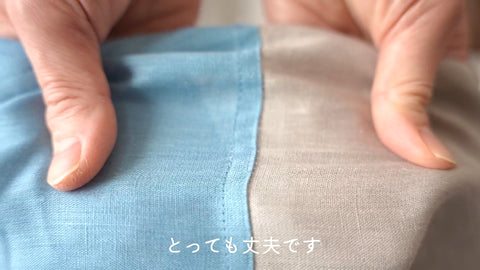
For example, two 5 kg bags of rice (10 kg in total) can be put in it with no problem.

Some customers say that the fabric of this bag is thick and soft to the touch, even when holding heavy objects, so fingers do not get sore.

It can be used in a variety of ways, such as hanging on the shoulder, hanging on the arm, or as a handbag, by changing the position of the tie according to the amount of luggage.

If you wash it in the washing machine as soon as you get home, any dirt or viruses that may be bothering you will be washed away clean.

Cheerful Colors
Now let's talk about color. It is said that color has the power to move emotions. Therefore, we decided to use a combination of colors that would be bright and cheerful. What do you think? Doesn't it make you feel cheerful just by looking at them?

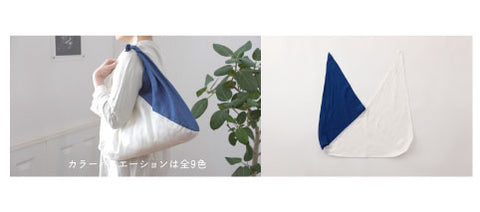







Currently, there are 9 color cmbinations. Have you ever found favorite one?

Read more
“Life is but a tissue of habits.”
— Henri-Frédéric Amiel
If we believe that, we can change our life by changing our habits. And I think that good habits are about having a good routine in our daily life. In this blog, I would like to introduce our products as things to accompany such a good daily routine.
Yarn-dyed Linen Daily Bag
Now, we would like to introduce our Yarn-dyed Daily Bag. Its fabric is a yarn-dyed linen fabric woven in our own factory. Of course, it is selvedge linen. The luster and coloring unique to yarn-dyed linen fabrics look just like a silk scarf. We hope that you will use this cloth bag as your companion when you go out for shopping, etc., with the same excitement as when you go out wearing your favorite scarf.


The Origami Culture
Let's take a quick look at what AZUMA BUKURO is all about. When you look at how it is made, you will be amazed at its wisdom. Please look at the diagram below.
First, prepare a rectangular piece of cloth. Fold it into three equal parts.

Next, sew A and B together at the red dotted line.

Then, insert C between A and B, which were sewn together earlier, and now sew B and C together at the green dotted line.

Finally, turn it over and you are done.

What do you think? Just two stitches are all it takes to make a bag. And if you have a rectangle of fabric, you don't even need scissors. I think that perhaps it comes from the origami culture.
The Washable Bag

One of the advantages of linen is that it dries quickly after washing.

Sturdily Sewn
Now let's look at the details. Our main concern is its sturdy construction. It is designed to withstand considerable weight.
All seams are double stitched.

For example, two 5 kg bags of rice (10 kg in total) can be put in it with no problem.

Some customers say that the fabric of this bag is thick and soft to the touch, even when holding heavy objects, so fingers do not get sore.

It can be used in a variety of ways, such as hanging on the shoulder, hanging on the arm, or as a handbag, by changing the position of the tie according to the amount of luggage.

If you wash it in the washing machine as soon as you get home, any dirt or viruses that may be bothering you will be washed away clean.

Cheerful Colors
Now let's talk about color. It is said that color has the power to move emotions. Therefore, we decided to use a combination of colors that would be bright and cheerful. What do you think? Doesn't it make you feel cheerful just by looking at them?









Currently, there are 9 color cmbinations. Have you ever found favorite one?

Read more
“Life is but a tissue of habits.”
— Henri-Frédéric Amiel
If we believe that, we can change our life by changing our habits. And I think that good habits are about having a good routine in our daily life. In this blog, I would like to introduce our products as things to accompany such a good daily routine.
Folding weave Blanket&Folding weave linen large cloth
Now, I would like to introduce the Folding Weave Series. It sounds somewhat unfamiliar, doesn't it? That is as it should be. The name "folding weave" is a term I coined. To explain it simply, this textile is like a newspaper. When you read a newspaper, it is folded vertically and unfolded. This textile is folded in two just like a newspaper. I will explain what this means step by step.

During the weaving process, the cloth becomes like a newspaper folded in two.

This is what it looks like during weaving.

As unfolded the newspaper to open it, another piece of cloth peeked out from underneath.

The left half is checkered and the right half is plain. And the whole is a framed pattern.
Folding weave is really a double weave
First of all, double weave is woven just like two layers of cloth. Double gauze is probably the most familiar to most people. It is often used for towels and clothing. Its characteristic is that it is a "single piece of cloth" woven from two separate pieces of fabric woven as if they were layered together.

The underside (back side) of the double weave is being woven. The underside cannot be seen because many warp threads are being pulled up.

This is a view of the top side being woven. When weaving the upper surface, the warp threads for the lower surface are not needed, so the number of warp threads to be pulled up is reduced and the check pattern on the lower surface is clearly visible.
The reason for double weaving
One of the usual reasons for double weaving, as in double gauze, is to soften the texture. By double weaving, the cloth is divided into upper and lower sections, and the contact points between the warp and weft yarns are reduced, resulting in a softer cloth. At the same time, the double layer of fabric becomes fluffy to the touch because it is filled with air.

Air layer is created between the top and bottom surfaces.
Folding weave with a different purpose than regular double weave
However, the purpose of double weaving in this product is a little different. The answer lies in the design. Let's take a look at the design. This design features a plain weave on one side, a check on the other, and a framed pattern throughout.

In the case of normal weaving, one weft thread runs from the left end to the right end. If half the textile is checkered, the other half could not be plain.
To give shape to the design
This product is a yarn-dyed fabric, meaning that the yarn is dyed first and then woven. Normally, one weft thread is woven seamlessly from the left end to the right end of the cloth. It means that the same color should continue from the left end to the right end. However, the design of this product is plain on one side and check on the other side. In a normal weave, the color of the checks should continue from one end to the other. However, that is not the case with this design. This is why we came up with the folding weave.

We thought we could give shape to the design by weaving one side (front) into a solid color and the other side (back) into a checkerboard pattern, and then unfolding it out.
Weaving unique to the shuttle loom
Our loom is a shuttle loom, which is now an obsolete loom. However, since the weft is woven in the same way as on a hand loom, a weft thread is always folded over at both ends of the cloth. It means that the weft is always connected. These two ends are called "selvage or selvedge In English. This selvage is what makes the folding weave possible.

The top and bottom surfaces are always connected at either end.

Folding weave cloth just after weaving.
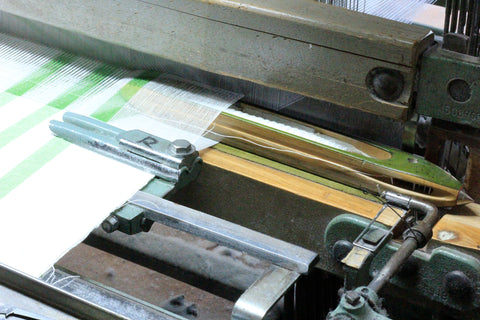
The selvedges are made using a tool called a shuttle, which carries the weft yarn.
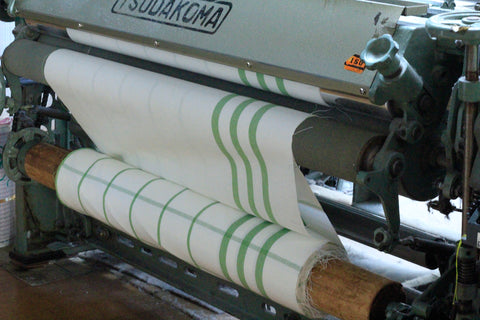
Weaving in progress.

On the right side, the cloth is clearly visible in two pieces.

The left side is not in two pieces because it is folded on this side.
We were thus able to create a checkered pattern on one side and a plain weave on the other half, but there was the last hurdle to overcome. When this product is unfolded and viewed as one large piece, it must be made into a picture frame pattern.

A picture frame pattern is like a pattern with a window frame, so weaving from the bottom to the top of the frame requires a significant amount of pattern paper. This product is more than 2m long before sewing, so the amount of pattern paper is enormous.

Once we have made a pattern paper like this, it is convenient to weave many more cloth, all of which will have the same pattern and length. One round of this paper is enough to weave one cloth. The reason this is such a large quantity of pattern paper is because the design is a framed pattern.
The double weaving technique and a large number of pattern papers are used to create this folding weave series. This is one of the proudest products.
Folding weave blanket(50%Linen, 50%Lambwool)


Folding weave lenen large cloth(100%Linen)


Finally, a piece of linen in the daily routine.
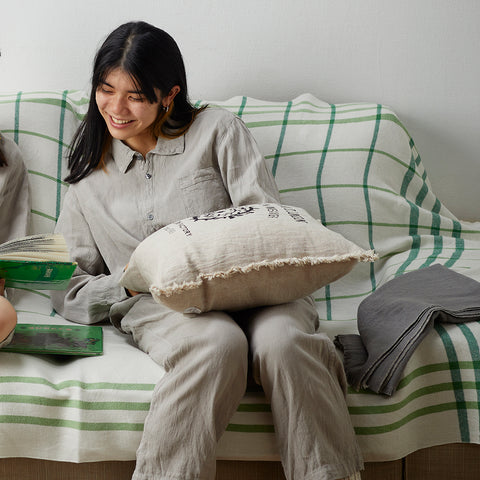
「Folding weave linen large cloth」
Read more
“Life is but a tissue of habits.”
— Henri-Frédéric Amiel
If we believe that, we can change our life by changing our habits. And I think that good habits are about having a good routine in our daily life. In this blog, I would like to introduce our products as things to accompany such a good daily routine.
Folding weave Blanket&Folding weave linen large cloth
Now, I would like to introduce the Folding Weave Series. It sounds somewhat unfamiliar, doesn't it? That is as it should be. The name "folding weave" is a term I coined. To explain it simply, this textile is like a newspaper. When you read a newspaper, it is folded vertically and unfolded. This textile is folded in two just like a newspaper. I will explain what this means step by step.

During the weaving process, the cloth becomes like a newspaper folded in two.

This is what it looks like during weaving.

As unfolded the newspaper to open it, another piece of cloth peeked out from underneath.

The left half is checkered and the right half is plain. And the whole is a framed pattern.
Folding weave is really a double weave
First of all, double weave is woven just like two layers of cloth. Double gauze is probably the most familiar to most people. It is often used for towels and clothing. Its characteristic is that it is a "single piece of cloth" woven from two separate pieces of fabric woven as if they were layered together.

The underside (back side) of the double weave is being woven. The underside cannot be seen because many warp threads are being pulled up.

This is a view of the top side being woven. When weaving the upper surface, the warp threads for the lower surface are not needed, so the number of warp threads to be pulled up is reduced and the check pattern on the lower surface is clearly visible.
The reason for double weaving
One of the usual reasons for double weaving, as in double gauze, is to soften the texture. By double weaving, the cloth is divided into upper and lower sections, and the contact points between the warp and weft yarns are reduced, resulting in a softer cloth. At the same time, the double layer of fabric becomes fluffy to the touch because it is filled with air.

Air layer is created between the top and bottom surfaces.
Folding weave with a different purpose than regular double weave
However, the purpose of double weaving in this product is a little different. The answer lies in the design. Let's take a look at the design. This design features a plain weave on one side, a check on the other, and a framed pattern throughout.

In the case of normal weaving, one weft thread runs from the left end to the right end. If half the textile is checkered, the other half could not be plain.
To give shape to the design
This product is a yarn-dyed fabric, meaning that the yarn is dyed first and then woven. Normally, one weft thread is woven seamlessly from the left end to the right end of the cloth. It means that the same color should continue from the left end to the right end. However, the design of this product is plain on one side and check on the other side. In a normal weave, the color of the checks should continue from one end to the other. However, that is not the case with this design. This is why we came up with the folding weave.

We thought we could give shape to the design by weaving one side (front) into a solid color and the other side (back) into a checkerboard pattern, and then unfolding it out.
Weaving unique to the shuttle loom
Our loom is a shuttle loom, which is now an obsolete loom. However, since the weft is woven in the same way as on a hand loom, a weft thread is always folded over at both ends of the cloth. It means that the weft is always connected. These two ends are called "selvage or selvedge In English. This selvage is what makes the folding weave possible.

The top and bottom surfaces are always connected at either end.

Folding weave cloth just after weaving.

The selvedges are made using a tool called a shuttle, which carries the weft yarn.

Weaving in progress.

On the right side, the cloth is clearly visible in two pieces.

The left side is not in two pieces because it is folded on this side.
We were thus able to create a checkered pattern on one side and a plain weave on the other half, but there was the last hurdle to overcome. When this product is unfolded and viewed as one large piece, it must be made into a picture frame pattern.

A picture frame pattern is like a pattern with a window frame, so weaving from the bottom to the top of the frame requires a significant amount of pattern paper. This product is more than 2m long before sewing, so the amount of pattern paper is enormous.

Once we have made a pattern paper like this, it is convenient to weave many more cloth, all of which will have the same pattern and length. One round of this paper is enough to weave one cloth. The reason this is such a large quantity of pattern paper is because the design is a framed pattern.
The double weaving technique and a large number of pattern papers are used to create this folding weave series. This is one of the proudest products.
Folding weave blanket(50%Linen, 50%Lambwool)


Folding weave lenen large cloth(100%Linen)


Finally, a piece of linen in the daily routine.

「Folding weave linen large cloth」
Read more
“Life is but a tissue of habits.”
— Henri-Frédéric Amiel
If we believe that, we can change our life by changing our habits. And I think that good habits are about having a good routine in our daily life. In this blog, I would like to introduce our products as things to accompany such a good daily routine.













Read more
“Life is but a tissue of habits.”
— Henri-Frédéric Amiel
If we believe that, we can change our life by changing our habits. And I think that good habits are about having a good routine in our daily life. In this blog, I would like to introduce our products as things to accompany such a good daily routine.













Read more
“Life is but a tissue of habits.”
— Henri-Frédéric Amiel
If we believe that, we can change our life by changing our habits. And I think that good habits are about having a good routine in our daily life. In this blog, I would like to introduce our products as things to accompany such a good daily routine.
Good-sized Blanket



 There are many strings hanging from the top, which is a piece of jacquard device.
There are many strings hanging from the top, which is a piece of jacquard device.




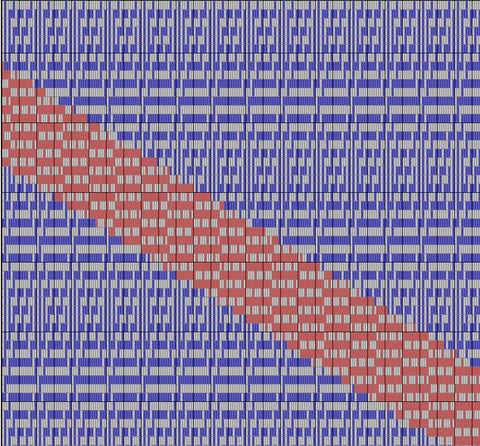




Finally, a piece of linen in the daily routine.

Read more
“Life is but a tissue of habits.”
— Henri-Frédéric Amiel
If we believe that, we can change our life by changing our habits. And I think that good habits are about having a good routine in our daily life. In this blog, I would like to introduce our products as things to accompany such a good daily routine.
Good-sized Blanket



 There are many strings hanging from the top, which is a piece of jacquard device.
There are many strings hanging from the top, which is a piece of jacquard device.









Finally, a piece of linen in the daily routine.




